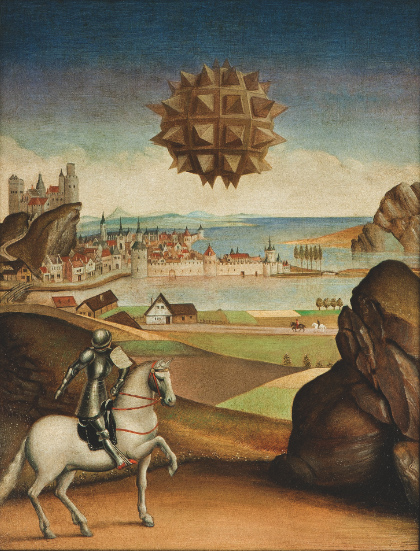Laurent Grasso’s “Future Archeology”
By Kathy Zhang

LAURENT GRASSO, from "Studies into the Past" series, 2010
French artist Laurent Grasso’s long fascination with modern physics, science fiction and conspiracy theories is apparent in the work he has produced over the past decade, including video, sculpture and recently painting. All of these mediums, and his familiar motifs, are represented in the exhibition “Future Archeology” at Edouard Malingue Gallery, which opened in late April, creating a fantastical overall narrative that treats paranormal activity and science fiction as genuinely as objective truths—such as one of Grasso’s common themes: the solar eclipse.
“Future Archeology” highlights Grasso’s latest works, a series of oil paintings, described by the humorously misleading title “Studies from the Past” (2010–2012), as though they are copies of extant works in the canon of Renaissance painting. Also part of this series are watercolors that are not, however, on display. When painting these, Grasso purposely used boiled oil so that the resulting works would darken when exposed to light, hence appearing aged and more “authentic.”

Installation view of LAURENT GRASSO’s wood sculpture Anechoic Wall (left), 2011, 90 × 162 × 18 cm, and oil on wood panel painting from "Studies into the Past" series (right), 2010
The phenomena of solar eclipses are common knowledge today, unlike during the European Renaissance era, when the workings of the solar system were only beginning to be understood by certain intellectual circles thanks to pioneering scientific minds such as Copernicus, Galileo and Kepler.
While astronomy was a source of fascination for artists and intellectuals at the time, historically speaking, the late 16th century painting known as Astronomers Studying an Eclipse, by the Frenchman Antoine Caron, is believed to be one of the only accurate depictions of astronomical phenomena from the Renaissance period still in existence. It shows a group of men in the court of Catherine de Medici pointing and looking at a fully eclipsed sun in a reddened sky. One man busily draws out a diagram with his compass; another points to an armillary sphere on the ground. Earlier documents were typically symbolic, such as the 14th century painting Annunciation to the Shepherds, attributed to the Italian Taddeo Gaddi—the artist is reputed to have been blinded from staring at the sun while in eclipse—in which two shepherds, awoken from their slumber, look in fear and awe at a blinding light in the sky, emanating from an angel.

LAURENT GRASSO, Radio Ghost, 2003, single-channel video, 32 min. Courtesy Edouard Malingue Gallery, Hong Kong.
Grasso’s paintings work in this uncertain space of historical images. In one of the paintings from Grasso’s “Studies from the Past,” two mounted knights traveling a dirt road gaze upward at a huge, looming and fully eclipsed sun. Strangely, they look upon the phenomenon with calm interest—rather than the shock one might expect of people who lack the reassuring knowledge of planetary physics. This is an intentional idiosyncracy by Grasso, who relates the blasé figures to today’s global citizens who take for granted their everyday conveniences and common knowledge, for example about the shape of the universe, which are only possible thanks to centuries of scientific inquiry.
In a similarly composed painting, another “Sudies from the Past,” a man on horseback looks with the same expression of mild intrigue upon a geometrical, obviously manmade object hovering above the path between the traveller and his destination, a kingdom on the distant coastline. The object, a spherical polyhedron (like a soccer ball) covered in spikes, is replicated in Anechoic Wall (2011), a wooden sculpture mounted on the adjacent wall, which appears to be an unfolded version of the shape. This is another one of Grasso’s fabricated artifacts that could hypothetically exist in the future. However, the audience, who has not yet experienced that would-be future, are confounded by such images and objects. One wonders: Is it a surveillance device? An alien craft, or a time machine perhaps?

LAURENT GRASSO, Anechoic Pavilion, 2012, single room cabin installed on the roof of Central Ferry Pier Four along Victoria Harbour, Hong Kong. Courtesy Edouard Malingue Gallery, Hong Kong.
In a separate room, Grasso’s video Radio Ghost (2003), which the artist filmed on his first excursion to Hong Kong, depicts a series of slowly panning aerial views of this Asian metropolis, which stall, waver and seem to aimlessly wander through the cityscape. Inspired by paranormal events allegedly heard over the city’s radio waves, throughout the film the artist recounts a series of nightmarish encounters with ghosts. Are we perceiving a dream, a scientifically intelligible process (even if it is a hypothetical one), or complete fiction? "Future Archeology" does away with the ostenisibly logical notion of linear history and blurs the line between empirical and subjective reality—playfully questioning accepted ways of perceiving the world in the psychologically numbing information age.
Also, in conjunction with the exhibition, Grasso has installed a prototype meditation room called Anechoic Pavilion on the rooftop of Central Ferry Pier Four, a simple wooden construction with one glass wall that faces Victoria Harbour, which will remain there until June 16 as a space envisioned for visitors to escape the constant activity of the city.







